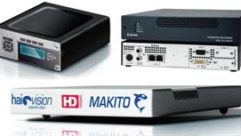
Extron and Electrosonic Do Business
Apr 12, 2010 3:26 PM, By Cynthia Wisehart
Many of you already know that my husband, Jim Bowie, is the president of Electrosonic. As we went to press, the company made headlines that would have been interesting even if I didn’t have a backstage pass. I’ve been watching the blogs discuss Extron’s purchase of Electrosonic’s product division. Gary Kayye was one of the first to chime in, noting that Extron president Andrew Edwards specifically emphasized Electrosonic’s IP-based technology. Kayye immediately zeroed in on a key takeaway: “Still think you can survive in the pro AV industry without understanding the network?” he asked. “Think again!”
Elsewhere, there was insightful discussion, but as always happens, assumptions are made and history is rewritten. I think the most interesting mischaracterization was the idea that Electrosonic was a hardware company that morphed into a systems integrator in the late 1990s. In the 20 years that I’ve been close to the company, that wasn’t what I observed.
Electrosonic’s co-founder, Bob Simpson, is a well-known industry pioneer and expert. Electrosonic began as—and remains—an engineering company. Electrosonic has always made products (remember its industry-standard videowall processors in the 1990s?). And it has always designed and integrated systems, including work on many of the world’s largest theme parks and museums (not just for videowalls and digital signage applications). Some of the products were created to fill a need from the creative people or provide technology that was not yet widely available (such as low-cost HD players in the ’90s). It’s been a simultaneous evolution, not a sequential one, as some have suggested. This is important mainly because it relates to the way Electrosonic pioneered technology: The company was a power user, and much of its innovation grew out of the trenches—starting 45 years ago when multiple-slide projectors were cutting edge.
Since then, the interplay between systems and products has taken many turns. For example Electrosonic was a key innovator in 3D presentation; it helped revolutionize ride films (and will do so again this June). Although the videowall processors were perhaps the company’s best-known products, and their most recent media players and processors are widely deployed in entertainment and command and control, the company has always committed heavily to the development of underlying technology, especially in image processing and compression. So as Kayye and others have observed, Extron didn’t just buy product lines, it also bought hard-won development that was ready for the next level. Electrosonic could not do much more with it as a systems integration company and without the manufacturing and distribution muscle that Extron has.
The potential for Extron is far more interesting than whether it will now morph into systems integration too, as some posters have mentioned. They’re all engineers over there, and this move is about engineering and the work still to be done to modernize our industry for the coming decade. Modern products will need to be ever more networked and less hardware-oriented. Edwards clearly sees that, and it obviously drove the acquisition. Beyond that, it’s always risky for journalists to guess what engineers will do with something. It won’t be the same thing journalists would do.








